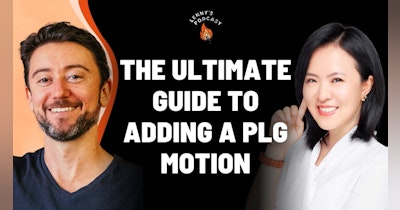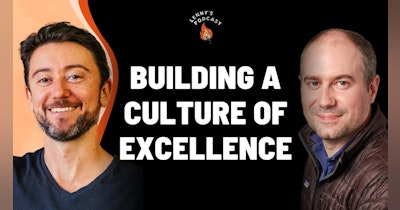Ian McAllister is the Senior Director of Product for Vehicles at Uber. Previously he was Director of PM at Airbnb, where he worked with Lenny and spent a decade creating and leading Amazon Smile. He studied finance and economics, worked on marketing and software development in his early career, and transitioned to PM after a gig at Microsoft.
He’s known for What distinguishes the top 1% of PMs from the top 10% and his thoughts on Amazon’s “working backwards” process, on Quora.
You can also see the episode transcript and Ian’s references:
Key takeaways
- Writing in public had a big impact on Ian’s product career. The Quora post, for example, has helped him make connections in the industry and synthesize and structure his thoughts.
- Top skills 1% PMs excel at (and that senior PMs should emulate), in order of priority:
-
-
- Communication. Keep asking yourself, “How could I answer that question better?” or ask your manager for this.
- Prioritization. The question to ask, after you’ve figured out what objective to hit, is which teams to talk to and how to sequence the project well. It’s simple but not easy. Even time management is a prioritization function.
- Execution. Execution means molding what you want to build into a simple, compact package that has the highest impact possible.
-
- Most people misunderstand “working backwards” and focus on the solution too much. Working backwards is about obsessing over the problem and the customer. Amazon’s “Press Release” template is just a trick to get you to think about the problem you’re solving, but it’s not the only way to do it, and the important thing is the spirit of working backwards. “This working backwards process doesn’t have to be efficient, because the prerequisite to being efficient is knowing where you’re going.”
- You might be working backwards if the problem feels compelling even before you get into the solution. With a painful problem and a big audience, think about the painkiller and the vitamin.
- Ian’s favorite interview question: “At this stage in your career, what have you learned about yourself?” or “Are you different from other people?”
How to communicate and prioritize better ▶
- Follow the Operator’s Manual checklist and the Pyramid Principle to communicate better.
- On communication: When questions should be answered by a date; who questions should be answered by a name. Know how to use numbers to answer questions. Answer questions directly and concretely, and avoid weasel words.
- On date: Be conservative in estimating deadlines, and expect to be held accountable for meeting them. Use common abbreviations for specific deadlines (COB, EOD, EOW), and assume that any dates given will be communicated to higher-ups with your name attached.
- On deliverables: If asked for a deliverable by a certain due date, send the document by that date or schedule a meeting to occur by that date and bring any requested documents for review.
Early in his career once, when asked when this feature will ship, Ian gave a lot of background, like X is delayed, Y is taking longer to get there, etc. But he didn’t even answer the question. This made him realize the principles of “Answer first and then explain” and “Own your problems.”
- The question to ask after you’ve figured out what objective to hit is which teams to talk to and how to sequence the project well. It’s simple but not easy. Even time management is a prioritization function.
- There is no simple trick to prioritize, but working backwards is a good technique to guide it. Lenny has covered prioritization in detail, e.g. the LNO framework of Shreyas Doshi can 5x a PM’s impact.
How to level up as a PM ▶
Communication is still the most important skill, according to Ian, even for senior PMs.
- The flywheel: Each challenge presents an opportunity to further hone the three skills (think big, earn trust, and drive impact); each opportunity leads to a new success; and each success leads to a bigger and more impactful challenge, allowing PMs to continue driving significant impact, further propagating the flywheel of honing the skills and getting to more impactful successes.
Three skills of the flywheel:
- Drive impact: As you grow more senior, you will be evaluated more on the impact you can have on the business. Early in your career, try to work on something that is likely to have a lot of impact (if you have a choice).
- Think big, not just in terms of scale but even your own responsibility as a PM. Take a very wide view on anything that influences the success of your product or customers, and not just buckets of what is classically “product or tech.” You own marketing or other functions until you find someone else to own it.
- Earn trust: When Ian was working at Airbnb to make customer support more efficient, he was heads-down in doing it in the way he wanted it (bullheaded). Instead, partnering more with the customer support leadership team may have led to better results.
Other skills: Simplify (do more with less). Forecast and measure (what separates PMs from consultants). Understand technical trade-offs (you don’t need to code to understand the foundations). Know good design (helps align with the customer). Write effective copy (get good at communicating with greater signal than noise). Dig for data (if the data isn’t available, make it available). Push back effectively and adapt to change.
Working backwards at Amazon ▶
Why people tend to stick around at Amazon for a while
- Ian worked at Amazon for around 12 years. At Amazon, people tend to know pretty quickly whether they’re a fit for it or not. You learn from documents, weekly business reviews, and from everyone else. The learning that happened at Amazon helped Ian propel his career, where particularly Jeff Wilke (former CEO of Amazon’s Worldwide Consumer) showed tough love.
The working backwards concept vs. the working backwards process
Ian described Amazon’s approach of working backwards, where a product’s press release is written before the product itself, which can be useful for organizations lacking development templates. He also differentiated this from the concept of working backwards, which priorities solving customer problems and building from there, rather than the reverse approach of forcing a solution onto a problem.
What people get wrong about working backwards ▶
- People who say they work backwards generally actually start with a solution and then say, “We could do this…” If it’s not grounded around the customers, you aren’t working backwards.
- In a meeting once, Jeff had sketched out an idea of linking different Amazon products. The team was really excited and there was a lot of momentum to try and build it. But it was a solution and not a problem. The working backwards process was retrofitted to make it work as a solution, and ultimately the project failed.
The working backwards template ▶
Example press release on LinkedIn here. More detailed post on Quora from Ian.
Ian’s recommendations
- Getting Real by 37signals, specifically the chapter on epicenter design
- Energy and Civilization by Vaclav Smil
- How I Built This podcast with Guy Raz
This is a human edited summary of the podcast episode with Ian, by Gaurav Chandrashekar (@cggaurav, productscale.xyz). To listen to the full episode, go here.








